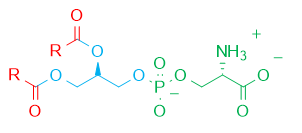6/15/2024
In eukaryotic cells, the distribution of lipids across biological membranes is asymmetrical. Specifically, sphingolipids, sphingomyelins, and phosphatidylcholine are predominantly distributed on the outside of the cell membrane. In contrast, aminophospholipids such as phosphatidylethanolamine and phosphatidylserine (PS) are predominantly distributed on the inside of the cell is a class of compounds consisting of a long-chain fatty acid, a glycerol skeleton, and a phospholipid headgroup. Its structural formula is illustrated in the figure below:
Figure 1: General structural formula of Phosphatidylserine
Phosphatidylserine is the most abundant anionic phospholipid in eukaryotic cells, accounting for about 10% of the total lipids in cells. It plays a key role in regulating the fluidity and permeability of cell membranes and can activate the metabolism and synthesis of a variety of enzymes. In addition, PS has a positive effect on improving the function of nerve cells, regulating nerve signal transmission, and enhancing brain memory function.The human body can synthesize PS autonomously and obtain it through external channels such as food. The concentration of PS is particularly prominent in the membrane structure of brain nerve cells, and its asymmetric distribution on the membrane is essential for maintaining cell normal physiological function.
In healthy cells, PS participates in a variety of physiological functions such as coagulation, myoblast fusion, and T lymphocyte activation. It is a unique feature of apoptosis and can provide recognizable and distinguishable signals for apoptosis. In healthy cells, PS is located inside the cell membrane. When cells begin to apoptosis, PS flips from the inside of the cell membrane to the surface of the cell membrane and is exposed to the extracellular environment, thereby acting as a signal of apoptotic cells and being recognized and cleared by PS receptors expressed in macrophages.In the tumor microenvironment, the exposure of PS on the surface of tumor cells and immune cells is associated with immunosuppression and promotion of tumor growth. Therefore, the location of PS on the cell membrane is of great significance for cell survival, growth, proliferation, and cancer-related symptoms.
Targeting PS is considered a promising strategy for cancer treatment. In recent years, scientists have developed a variety of PS-targeting drugs for cancer treatment. In clinical trials, bavituximab, as a single drug or in combination with other traditional treatments, is effective in the treatment of lung cancer, hepatocellular carcinoma, breast cancer, pancreatic cancer, and other solid tumors, with relatively few side effects. In addition, bavituximab combined with sorafenib for the treatment of hepatocellular carcinoma and gemcitabine for the treatment of pancreatic cancer also showed significant therapeutic effects. These findings have opened up new possibilities for cancer treatment. In addition, antibody-drug conjugates and liposome carriers are potential PS-targeting strategies for treating tumors.In neurobiology, PS is abundant in the membrane of nerve cells and is essential for nerve cells' survival, repair, and function. The main effects of PS in the central nervous system include promoting the release of dopamine, increasing the production of the neurotransmitter acetylcholine, improving the efficiency of brain glucose metabolism, reducing the level of hydrocortisone, and enhancing the activity of nerve growth factor. Therefore, PS plays an important role in a variety of central nervous system diseases, including Alzheimer's disease, Parkinson's disease, depression, ischemic stroke, autism, attention deficit hyperactivity disorder, schizophrenia, and spinal cord injury.
With age, the cholesterol level in the brain increases, and the Phosphatidylserine (PS) content decreases, which leads to weakened enzyme activity in brain cells, reduced cell transport capacity, and reduced synaptic connections, ultimately causing memory loss. Alzheimer's disease (AD) is a chronic neurodegenerative disease and the most common disease in the Alzheimer's series. Relevant clinical studies have shown that supplementing 100 mg of PS thrice a day for 12 consecutive weeks can significantly improve AD patients' cognitive function and memory. At the same time, the combination of 300 mg of PS and 240 mg of PA has also shown a positive effect on improving patients' mood and daily quality of life.Phosphatidylserine is a phospholipid nutrient that occurs naturally in the human body, especially in metabolically active organs such as the brain, lungs, heart, liver, and skeletal muscle. PS can bind to various proteins and participate in regulating various biological processes, including enzyme activation, cell apoptosis, and the transmission of nerve signals. PS supplementation not only has a positive effect on treating central nervous system diseases such as Alzheimer's disease but also shows potential in cancer treatment. It is also widely used in nutrition to improve mood and health, cognitive function, and athletic performance, relieve muscle soreness, and improve sleep.
The Thornton team's research results show that supplementing PS can effectively improve the cognitive function of young and healthy college students. This is specifically manifested in a 20% increase in calculation speed, a 39% reduction in the total number of errors, and a 13% increase in the total number of correct calculations.
In addition, PS can also enhance an individual's ability to resist stress and reduce the physiological stress caused by excessive exercise. Researchers such as Lu Jiaojiao and An Yan have found that high-level shooting athletes who supplement 800 mg/d of PS before the game can improve their psychological stress adaptation ability by reducing cortisol levels and improving mood and sleep quality.In summary, PS has a wide range of applications in medicine and nutrition. However, it is difficult to obtain a single, high-purity PS from soybeans or animal organs. High-purity PS with a single chemical structure usually requires chemical synthesis. Our company can provide various types of high-purity Phosphatidylserine to scientific researchers. Friends in need are welcome to call us for inquiries!
References:
Please fill out the form below and our sales team will be happy to assist you with a quote on peptide synthesis reagents.
